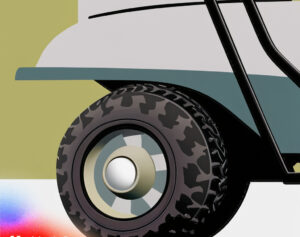A golf cart is more than just a vehicle for leisurely cruising around the golf course. It’s a miniaturized marvel of engineering, with its own set of unique components. One critical aspect that often doesn’t get the attention it deserves is the golf cart’s braking system.
The often-overlooked component, the brake, must be comprehended and taken into account if you plan to keep your golf cart in the best possible condition.
Explanation of the importance of golf cart brakes and why understanding how they work is essential
Boost Safety: Your safety and everyone else’s on board a golf cart largely depend on functioning, efficient brakes.
Here’s a rundown on how these critical components work:
Golf Cart Brakes: Working Principle

- Mechanism: Similar to standard car brakes, golf cart brakes primarily use a mechanical process to slow or stop your vehicle. When you press the brake pedal, it engages a set of brake shoes.
- Friction: These brake shoes press up against a drum or disc (depending which type of brake system your cart uses), producing resistance or friction.
- Reducing Speed: As a result of the friction, the wheels slow down or come to a halt. The entire process is swift and may happen numerous times during any given ride.
- Regular Servicing: Now that you understand how a golf car’s brakes work, it becomes evident why regular servicing is vital – to keep these elements clean and operational for those times when you need to stop unexpectedly.
Understanding the basic functioning of your golf cart’s braking system can help maintain its performance and prolong its lifespan. After all, while smooth rides are crucial, stopping safely at will is equally significant!
Types of Golf Cart Brakes
When you are out on the greens, enjoying a delightful round of golf, golf carts come in handy. However, the safety and functionality of these carts largely hinge on their brake system. There are primarily two categories of brakes utilized in golf carts: mechanical and hydraulic.
Overview of Mechanical and Hydraulic Golf Cart Brakes:
Mechanical Golf Cart Brakes: Mechanical brakes operate manually, using a cable to engage the brake shoes when the brake pedal is pressed. The system is simple and practical. Certain golf cart models also have a parking brake feature integrated with this system.
Hydraulic Golf Carts Brakes: On the other hand, hydraulic brakes use fluid to increase pressure from the pedal to the brake shoes. They offer greater stopping power and are more common in modern golf carts due to their reliability and efficiency.
RELATED: How to Trick Golf Cart Charger?
How does it work?
1. Breaking Down Mechanical Brakes: When the pedal is pushed, the cable connected to the pedal pulls a lever on the wheel’s brake assembly. This causes two brake shoes to emerge, which creates friction against the wheel and forces it to slow down or stop.
2.Harnessing Hydraulic Brakes: These brakes work by pressurizing the hydraulic fluid in response to the pressure applied to the brake pedal. This fluid pressure then activates pistons that push out the brake pads onto a disc attached to the wheel axle, creating friction that decelerates or stops the cart.
Remember, golf cart maintenance requires regular servicing and checks of your braking system. Regardless of its type, an efficient braking system can vastly improve the safety of you and your cart on the course.
Mechanical Brakes
If you ever wondered how do golf cart brakes work, they operate similar to those found in regular cars. The only difference is that golf carts primarily use mechanical or drum brakes due to their suitability for the low speeds these carts move.
Explanation of how mechanical brakes work, including components such as brake cables, brake drums, and brake shoes.
Let’s break down how these mechanical parts work together to stop your golf cart.
- Brake Cables: Upon pressing the brake pedal, tension on the brake cables increases. These cables carry this force from the pedal to other components of the braking system.
- Brake Drums: Mounted on the wheel hub, the brake drum spins at the same speed as your vehicle’s wheel. When you apply brakes, these drums perform an essential role in decelerating the vehicle.
- Brake Shoes: Brake shoes are fitted inside the drum and are forced outward onto the inner surface of the drum when you press on the brake pedal. This friction between shoes and drum decreases the rotational speed of the wheels, causing your golf cart to slow down or stop.
Overall, despite its apparent simplicity, this system requires routine maintenance to ensure optimal efficiency and safety. It is critical to inspect and replace worn-out brake shoes on a regular basis, as well as to ensure that cables are in excellent shape and not overstretched.
Even though golf carts do not travel at high speeds like other vehicles, the necessity of properly maintained brakes cannot be overstated. Given that many accidents occur at low speeds as a result of these carts’ inadequately functioning brakes, taking good care of your golf cart’s braking system becomes a concern.
Hydraulic Brakes

Ever been curious about the inner workings of your hardworking golf cart brakes? Let’s delve into the fascinating world of hydraulic brakes! Commonly used on most golf carts, these braking systems rely on a few vital components for their function: brake fluid, master cylinder, brake calipers and brake pads.
Explanation of how hydraulic brakes work, including components such as brake fluid, master cylinder, brake calipers, and brake pads
How does it all come together? Well, let’s break it down:
The Master Cylinder: As the heart of a hydraulic brake system, the master cylinder initiates the braking process. Upon pressing the brake pedal, brake fluid gets pressurized inside this compartment.
Brake Fluid: This incompressible liquid transforms foot pressure into stopping power. It is responsible for transmitting the force from the master cylinder to the calipers.
The Brake Calipers and Pads: These parts clamp down on your golf cart’s wheels whenever you hit the brakes. The pressurized brake fluid causes the calipers to squeeze the brake pads onto the wheel’s rotor surfaces.
| Components | Action |
|---|---|
| Master Cylinder | Initiates braking process by pressurizing brake fluid |
| Brake Fluid | Transmits force of braking from master cylinder to calipers |
| Brakes Calipers and Pads | Squeeze onto wheel’s rotor surfaces when hydraulic pressure is applied |
As you can see, each part of a hydraulic braking system plays a critical role in the smooth operation of your golf cart’s stopping capabilities. Understanding how this system works will help ensure you maintain it properly for maximum efficiency and safety.
Brake Operation
A foremost aspect of golf cart safety and performance is an understanding of the brake system function. Knowing how your golf cart brakes work helps you prevent accidents and ensure a smooth ride.
So, how do golf cart brakes work?
Like any motorized vehicle, golf carts use a basic hydraulic braking system. To break down the process, let’s evaluate the role of key components.
A step-by-step explanation of how golf cart brakes are engaged and disengaged, including the role of the brake pedal or lever.
1.The Brake Pedal: As you press down the brake pedal, it activates a master cylinder that sends hydraulic fluid or brake fluid through lines to each brake.
2.The Hydraulic System: The hydraulic pressure then forces piston cylinders inside the brake caliper to push the brake pads against the rotor. This friction slows down or stops the golf cart wheels from turning.
3.Disengagement: As soon as you lift your foot off the brake pedal, the pressure reduces in the hydraulic system. The pistons draw back, reducing pressure on the pads and rotor, which allows for free wheel rotation again.
4.The Brake Lever: In most modern electric golf carts, an electronic motor brake provides additional stopping power. If you release the accelerator, it activates automatically. In manual carts, an analog, hand-operated drum-style parking brake ensures sustained standby halt.
In essence, Understanding how your golf cart brakes work is fundamental in ensuring safe rides. It allows you to assess braking issues and handle most maintenance tasks on your own. This knowledge can mean less downtime during your playtime while keeping your ride in top condition.
Brake Maintenance
In a golf cart, just like any other automobile, the braking system plays a critical role in ensuring safety. A properly functioning brake system is indispensable for maintaining control over the cart’s speed and preventing unexpected mishaps. So, how do golf cart brakes work, and how best to maintain them?
Tips and guidelines for maintaining and inspecting golf cart brakes
Knowing how to maintain and inspect your golf cart brakes can save you from steep repair bills and reduce potential accidents down the line. Here are some tips on how to go about it.
Brake Pad Replacement:
The brake pads are subject to wear over time, so regular inspections are necessary. When the brake pads have worn down to an unsafe thickness, they need immediate replacement. Top-quality disc brake pads ensure effective braking and prolonged service life.
Adjusting Brake Cables:
The brake cables, overtime, might loosen due to continued use. Hence, regular cable tension adjustment is necessary for efficient brake operation.
Maintaining Brake Fluid Levels:Ensure timely inspection of the brake fluid levels. Low fluid levels can lead to decreased brake efficiency and pose a safety risk.
Regular Professional Inspection:Finally, while personal maintenance is important, regular professional inspection of golf cart brakes should not be overlooked. Professionals can identify issues that might not be apparent to untrained eyes.
RELATED: How Big Is a Golf Cart Gas Tank?
How do they work?
At its most basic, pressing the brake pedal on a golf cart activates a system that imparts friction to the wheels, slowing them and, as a result, delaying or stopping the cart’s speed. The intricacy of a golf cart’s braking mechanism varies depending on the model and manufacturer.
Remember that a well-maintained braking system guarantees that your journeys around the golf course are not only fun but also safe.
Signs of Brake Issues

As a golf cart owner, it’s essential to understand how your cart’s braking system works to keep it functioning properly. One of the first steps is recognizing the signs that your brakes may need to be maintained or replaced.
Identification of common signs that indicate potential brake problems
- Squeaking or Grinding Noises: It’s pertinent to pay attention to odd sounds from your cart. Squeaking or grinding noises when you apply the brake could indicate a problem with the brake shoes or a poorly lubricated brake system.
- Increased Stopping Distance: If your brake begins to feel less responsive or require more distance to stop, it could be a clear indication of worn brake shoes or, in some cases, air in the hydraulic system.
- Soft Brake Pedal: The brake pedal should have a solid feel when you press it. A soft or mushy brake pedal could signify potential issues with your golf cart’s hydraulic system, including leaks in the lines or low brake fluid levels.
Understanding how your golf cart’s brakes work and being aware of symptoms such as squeaking, grinding noises, extended stopping distance, and soft brake pedals can help you identify and resolve issues before they become critical. Regular maintenance can increase the lifespan of your brakes, drastically improving the safety and overall experience you have with your golf cart.
Adhering to the best maintenance practices for golf cart brakes largely hinges on vigilance and responsiveness to prevent small issues from becoming significant problems — let’s remember, safety first!
Safety Considerations
A smooth ride in a golf cart can turn disastrous without ample attention to safety measures. A primary safety aspect to ponder on while riding or operating a golf cart is the efficiency of its brake system.
Importance of proper brake maintenance and safety precautions while operating a golf cart, including regular brake checks and observing speed limits
Maintenance Is Key: The braking system in a golf cart is crucial for maintaining control, especially during turns and when stopping abruptly. A poorly maintained brake system will not guarantee these, hence endangering lives. Regular brake checks are an essential part of your maintenance routine — ensuring the brakes’ proper function could be the difference between a safe ride and an accident.
Monitor Speed: Though golf carts aren’t designed for high speeds, it is vital to observe appropriate speed limits, especially in crowded or high-traffic areas. It allows enough reaction time and controls the cart effectively. Remember, speed limits are usually set where the risk associated with exceeding that speed outweighs any potential benefits.
How do golf cart brakes work?:
Just like cars, most traditional golf carts employ a mechanical braking system. When you push the brake pedal:
- Actuator:The actuator rod moves, which then pushes the master cylinder piston.
- Master Cylinder:The master cylinder then compresses brake fluid and sends it through the brake lines.
- Hydraulic Pressure: This hydraulic pressure then pushes the pistons inside the brake caliper.
- Caliper to Rotor:The calipers then clamp onto the rotor attached to the wheel.
This process creates friction against the wheel, slowing it down and ultimately stopping the golf cart. Therefore, maintaining these interconnected parts in their optimal working condition is paramount for your golf cart’s safe operation.
Conclusion- How Do Golf Cart Brakes Work
Finally, each golf cart owner should be familiar with the components and functions of golf cart brakes. Understanding how these various elements interact to provide that strong halt is not only intriguing; it is also vital for safety! This understanding is especially useful while driving on hilly roads or stopping rapidly to avoid an accident.
Summary of the key points discussed and the importance of understanding how golf cart brakes work for safe and enjoyable driving experiences
- A Firm Grip: Unlike automotive vehicles, golf carts typically use drum brakes. The action of applying the brakes makes the brake shoes inside the drum push outward against it, creating high friction that stops the cart.
- Pedal Function: There’s usually a single brake pedal for golf carts. Applying pressure to this pedal forces hydraulic fluid into the brake cylinders, propelling the shoes against the drum.
- Handbrake Mechanism: Most golf carts are also equipped with a handbrake for extra safety. This is especially useful when parking on an incline to stop the cart from rolling away.
- Maintenance: Over time, brake components will wear out and may need replacement. Regular inspection is essential to ensure your golf cart brakes are always in top condition.
Remember that every component of the golf cart braking system works together to ensure your safety as you travel about the course or your neighborhood. Understanding how golf cart brakes work not only improves your driving experience, but it also allows you to predict possible faults before they become major concerns.

I’m Donna Weiss, and I am the proud writer behind the captivating content you’ll find on golfneedy.com. As an avid golfer and passionate writer, I have combined my two greatest passions to bring you an incredible golfing experience. Through my articles, I aim to provide you with valuable insights, equipment reviews, and updates on the latest tournaments. Whether you’re a seasoned golfer or just starting out on this exciting journey, I am here to guide you and share my expertise. Together, let’s explore the fascinating world of golf, uncovering new techniques, and enhancing our skills. Join me on this thrilling adventure as we elevate our game and embark on an exciting golfing journey. Read More



